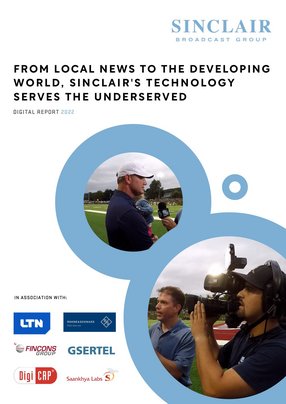Sinclair Broadcast Group officially started as one television station in Baltimore, Maryland, in 1971. Now it is one of the largest media providers, operating almost 200 television stations across the United States, is the largest U.S. local sports and tennis broadcast provider, and has a diversified business, including the manufacture of TV and radio transmission antennas and pioneering broadcast technology which it is bringing to the world.
Sinclair has built a reputation as a leader in broadcast technology and media evolution, serving multiple local US markets with linear and digital content, and paving the way for service to rural parts of the developing world. Its pioneering work on the NextGen Broadcast standard has made it possible for the new IP-based TV transmissions to engage with new 5G technology standards directly reaching mobile users worldwide.
“We started as one independent station that was built by Julian [Sinclair] Smith, the founder of the company. We now own or operate over 185 stations across the country in 86 markets almost all of which are network affiliates. This includes ABC, NBC Fox, CBS, CW,” says Chris Ripley, President and Chief Executive Officer. “We cover about 40% of the country with many top local news franchises attached to each one of those markets.”
Del Parks, a veteran of the company and its President of Technology, explained how the founder started Sinclair. Julian Smith and a small group of shareholders had formed a broadcast trade school in 1958 (Commercial Radio Institute, known as CRI), the same year that he applied to build an FM radio station. Smith saw that FM radio had better quality and better signal propagation to cover markets than AM radio.
“Julian Smith started this company with an FM radio station, which he built in 1964,” says Parks. It was a big gamble. “In the United States, in the 1960s, AM radio was king, even more so than TV.”
“The FM station was broadcasting in stereo when stereo pretty much didn't exist,” says Parks. “So, he built the equipment himself including consoles and multiple accessories. He was also running the technology school, which is where I met him. I started at the school in 1970 while he was building the TV station. So, some of the students pitched in and helped him build it.”
The company then built its Baltimore studio and another one in Pittsburgh in 1976, then another one in Columbus, Ohio in the 1980s. Acquisition of key stations and television groups throughout the country followed as Sinclair grew to gain its status as a Fortune 500 company in 2021.
Five years ago, the company entered the sports broadcasting market, acquiring Tennis Channel. In 2019, the group established itself as the major regional sports program provider when it acquired the Fox Sports regional sports networks, which it rebranded as “Bally Sports.” As the largest regional sports broadcaster in the United States, Bally Sports broadcasts about 5,000 live professional baseball, hockey and basketball games annually. Sinclair is seeking the same success as the growth of its television broadcast division as it joins hands with approximately 45 US-based teams. The sports play does not stop there.
“Our thesis is local news and sports are way more durable than entertainment programming, which has become ubiquitous, and for a smaller company like ours within the media landscape, we could carve out a niche there and have truly exclusive content,” Ripley says. “We did that by acquiring Tennis Channel and immediately began plans for increasing its distribution. It's now going global. It operates in eight countries now, including the UK, where it launched in August 2021.”
The growth of any company isn’t accomplished alone. Over the years, Sinclair has developed a significant partner ecosystem that has allowed the company to diversify and enter new areas rapidly. Those companies have been critical to Sinclair’s success and include: Televes, Fincons Group, Saankhya Labs, Rohde & Schwartz, DigiCap, and LTN Global.
Competition Through Diversification and Niche Dominance
By some metrics, Sinclair is relatively small within the media landscape currently dominated by tech giants like Google, Amazon, Apple, Disney, and Paramount. However, Sinclair, through its focused strategy, is pushing a huge range of agendas focused on direct-to-consumer content delivery.
“We are a very diversified company,” says Ripley. “The three big divisions are Broadcast, the Regional Sports Networks and Tennis Channel. But we've got other assets - some broadcast related like an antenna manufacturer and some wholly unrelated like a funeral home company. We have a basket of these other assets, which we call our investment portfolio, that amounts to about US$1.4bn.”
“We operate two data centers currently - one in Seattle and one in Baltimore - but we are in the process of a major transformation. We're moving much of our on-premises systems to the cloud,” says Parks. “The idea for centralization really is not centralization, it's really content sharing.” It serves as the forward-thinking growth infrastructure for all current and future content distribution.
An Entrepreneurial Mindset at Sinclair’s Core
The people at Sinclair drive a constant search for market gaps and innovations. They approach the company as entrepreneurs, with visions and missions that push them to find more profitable strategies.
“I think we're entrepreneurs to the core. And I think if you go back and look at the history of the evolution of technology and the broadcast industry, especially the transmission side of the equation, we're really the leader in the industry,” says David Smith, the company’s Executive Chairman.
David took the company with its couple of stations founded by his father and grew it to the titan it is today. While entrepreneurial and tech-focused, Sinclair also has the benefits and traditions of a family company. Smith carefully adds to that family by taking on people equally focused on an entrepreneurial vision for long-term growth and not constrained by “how things have always been done.”
Smith emphasizes his approach by noting, “We have people on staff who are very serious, technical patent people, electrical engineers and big picture industry planners who think about all these things in an effort to drive the future value of the broadcast industry, which is really based on its ability to have a piece of the spectrum, through which we can deliver all different kinds of services and products to the country, to the individual, to the government, anybody who needs it. You have to think of us – the broadcast industry – as a gigantic highway.”
Pulling an Industry into the Future with NextGen Broadcast
“Historically, the television broadcast highway was essentially unusable as it relates to anything on a mobile basis whatsoever,” says Smith. “So this new standard for the United States and other parts of the world provides absolute mobility, and it is a world-class standard that will provide the broadcast industry with the opportunity to do other things that it's never been able to do, therefore really expanding the value of the broadcast industry.”
Smith is talking about Sinclair's contribution to landmark innovation - ATSC 3.0, also known as NextGen Broadcast. It essentially enables broadcasting to be an integral piece of the 5G telecommunications ecosystem. The project is led by Sinclair’s Senior Vice President of Advanced Technology, Mark Aitken.
“We've invested tens of millions of dollars helping to develop the NextGen Broadcast standard, and no one else in our industry was willing to do that,” says CEO Ripley, “but that's the sort of entrepreneurial spirit and technology focus that we have, the expertise we have with guys like Mark [Aitken] and Del Parks and their teams that enabled us to do that.
“It was that long term vision, which caused us to be able to take that leap and invest in the future for which the rest of our peers had no appetite,” noted Ripley.
The technology repurposes the 6 MHz channel that television stations around the world use to transmit their signal. Developed by the Advanced Television Systems Committee - an international standards setting body - with substantial input from Sinclair - ATSC 3.0 - also known as NextGen Broadcast utilizes the existing infrastructure to do so much more than linear video programming to a fixed TV set in the home. Using the same “language” of the Internet - Internet Protocol or IP - broadcasters can now use their channels to enhance traditional programming significantly, reach mobile devices for the first time, hyper-localize content and advertising, combine over-the-air content with streaming content and distribute wholly new forms of non-video data. This brings the modern, fully mobile world, to old broadcast setups using technology already in place.
“It's never been used for anything other than typically delivering network television or news or entertainment to the television in your house,” says Smith. “Now we have the ability to talk to cars, telephones, anything that's mobile, any place, anywhere in the United States and we're working toward getting the adoption of the standard into all devices, into cars and mobile devices into everything that's capable of receiving over-the-air television signals.
The incremental value to our local TV stations by expanding to mobile viewers and targeting programming and advertising alone is worth the investment before you even get to all the new businesses created by this technology, says Smith.
“[It gives] the ability to talk to mobile devices, and being in the news business and the weather business, it gives us the ability to tell people, ‘Hey, there's a hurricane and there's a tornado. There's whatever coming in your neighborhood, get undercover’,” he says. “We're the only ones that can do that because we're on the ground live real-time and have that ability to connect two devices.”
Smith says this technology can save lives from extreme weather events, hazardous spills, police emergencies or any other critical events since the broadcast tech is one-to-infinite – everyone can receive the message simultaneously with no buffering, pixelation or lost signals. The broadcast tech can’t be overloaded.
“That's what we do. We're in the business of serving everybody that isn't rich,” says Smith. “A local television station covers a radius of typically 45-50 miles. We are able to touch everybody inside that radius, which is millions and millions of people across the country. We do that every day with a new broadcast standard.
“We're going to be able to build that out, so you won't have to be sitting in your house to watch us. You'll be able to watch us everywhere you are.”
Journeying to the Technology to Connect People
Mark Aitken worked for a small company, COMARK Industries, at a time in the TV industry when videotape was replacing film and the UHF spectrum was just beginning to be used by independent broadcasters. In 1979, COMARK’s founder, Richard Fiore Sr., started a partnership with David Smith and began manufacturing television transmitters. Those were the old analog days when people just had a square box monitor in their living rooms to watch a linear TV program. The world changed in 1995 when the United States began converting from analog to digital broadcasting - the so-called ATSC 1.0 standard. Suddenly, we had the promise and flexibility of a digital standard. But how best to exploit it?
“It made great HD pictures, but there's more than pictures in the minds of entrepreneurs and what you can do with the spectrum,” says Aitken. “We were already thinking about - how do we get into these small devices? How do we address a population of devices besides the TV set in the living room? Cell phones were around, people were now communicating, holding conversations and beginning on a personal level to communicate and flinging data to one another.”
After several years of trying to get the US to accept the European digital standard as an alternative to the more limited US version, Sinclair saw its attempts fail due to political factors, industry alignment, and a lack of vision.
“The vision of TV broadcasters was always about better TV, better pictures, better sound. So if your vision is - better pictures, better sound - then HDTV is king and you view the world one way,” says Aitken. “If you're trying to address a universe of devices that don't yet exist, you have a very different view of the world.”
The company has continued to focus on a more robust digital standard that would enable this future vision. Sinclair pushed the industry to develop and adopt a new standard. That became the new ATSC 3.0 standard and was officially approved by the Federal Communications Commission in 2017. Ripley notes that the existing TV standard is not nearly as efficient as the new one. The new tech, making use of the one-to-many efficiency of IP broadcasting, is more advantageous than the one-to-one distribution of the traditional broadband business. And importantly, the new IP based standard can do so much more than just TV programming.
“When you think about it, the best use cases are data that a lot of people want,” says Ripley. “Video is a good example of that because a lot of people watch the same videos. But then cars need a lot of information on a regular basis, especially as they become more autonomous and they generally need the same information, especially in a certain geography. So it's way more efficient to send it out once to all devices as opposed to one to one to every device.
“On top of that, in terms of just the spectral efficiency and ability to be received below noise levels, the technical performance of the NextGen standard versus any sort of multicast mode in 5G, demonstrates it has a much much greater spectral efficiency.”
“An example of that is LTE Multimedia Broadcast Multicast Service (MBMS), which not many carriers use, but it is available in normal cellular. These types of unicast services have a huge data overhead compared to ATSC Broadcast. That means if you're using LTE MBMS, you are only able to use a fraction of your bandwidth to actually carry the data.”
Sinclair plans to provide a hybrid experience combining NextGen Broadcast and traditional broadband delivery technology in one seamless experience.
“At least from an entertainment perspective and from a content perspective, that's going to be the main mode of operation and then having to be available on a direct consumer basis is a big push for us,” says Ripley. “Gamification is also another big push. We believe in the convergence of media and gaming. So think video gaming, but also sports betting, I think social gaming is all merging and we want to be on the forefront of that trend.”
Acceleration of Industry in the Most Underserved Areas
A couple of decades ago, newspapers kept local government in check, but the landscape is different now as local newspapers have declined. Sinclair considers itself the heir of that legacy.
“What we do in local news is very important, and that then transcends into digital, into our websites, into our mobile apps and then extending that out to regions,” Ripley says. “We've always leveraged our size and our editorial strength to deliver a service to the people that we serve, and technology is extremely important to that.”
The company believes NextGen Broadcast will allow them to be even more focused on delivering more local news to local communities.
“It's leveraging all our local TV station assets: local programming and local news with reporting “boots on the ground” on a nationwide basis,” says Aitken. “We're ideally positioned to leverage those assets that are going into local news and bringing those all together.
“Newspapers are suffering and failing in large quantities by virtue of the fact that they're still doing what they did a hundred years ago, that's just a fundamental design problem. They haven't adapted to the marketplace,” says Smith.
“This new technology will allow the broadcast industry to do essentially the same thing as everybody else from a delivery perspective. And remember: there's nobody that does what we do in the marketplace. Local television is the primary source of all news in the marketplace because we're live in real-time delivering everything that's going on, that's relevant in our view to the people. That's what we do.”
This technology, instead of implanting several million separately addressed phone numbers in cars or other gadgets, allows information to be distributed straight to a device without needing separate phone numbers, relying on IP addressing instead.
Sinclair, through its ONE Media division and Indian partner Saankhya Labs, is involved in proving out this NextGen Broadcast technology in India. “That's one of the focuses of this trial that we have in Bangalore. The wireless carriers are very interested in this one-to-many offload feature because their networks are so congested. And so they can do a seamless offload from a cellular unicast network to an NextGen 5G broadcast network,” said Ripley.
“From a consumer perspective, you don't know that you've switched networks, but now all of a sudden you're offloaded from a one-to-one network in 4G or 5G to a one-to-many network in broadcast land using a different piece of the spectrum where low-band spectrum, generally in the 600-700 megahertz range. It's a nice compliment in terms of offloading data types, where there's a lot of people who want the same thing.”
The alternative distribution system is well received in India where hundreds of millions of people have little to no connectivity. It goes through the broadcasters as the company puts transmitters on cell towers.
“This solution [was used] for things like e-learning, obviously video consumption, which is really big on mobile devices in India. This is a really powerful technology that can be way more efficient and cost-effective,” Ripley says. “It's being tested in big cities too where congestion on mobile networks is really the target, but then you get out into the rural areas where you've got a lot of people that really have very, very poor service to the internet.”
The technology enables a population of a billion-plus users to access the same or similar content broadcast at a lower cost.
“That's a big drive over the next 12 to 18 months and it also fits in with this wireless technology because it will open up new ways to use the wireless technology. Most of our business today is done through other people's distribution points,” says Ripley. “We distribute our local sports through pay-TV – through cable and satellite – and we do over-the-air. But only 15-20% of the people actually use the over-the-air signal. They generally get it retransmitted through cable and satellite.
“NextGen Broadcast will reach over 75% of the country [USA] by the end of this year. Approximately 5 million TVs will be sold in the US this year that are NextGen ready. And then we've got all this activity in other countries like India, where we're doing a huge trial in Bangalore with the local public broadcaster there.
“We hope to get into mobile devices as this market matures. Then you've got Jamaica, Brazil and Korea, which are actually looking at rolling out mobility within the 5G Broadcast deployment, so there's a lot going on internationally that we help support. Domestically, we've sort of hit escape velocity on this technology. The next stop for the rapidly-evolving technology is mobile devices and personal devices here in the US.”
NextGen Broadcast is on the road to becoming the premier global digital standard. It has significant advantages over the European, Japanese and Chinese standards and is compelling as countries like Brazil and India look to upgrade their content distribution technologies.
“It is set to become a significant global standard – probably not every country, but large, significant countries will adopt this standard because it is a much more efficient use of the spectrum, it is all IP based, it unlocks the spectrum from a mobility perspective and it has massive cost advantages over traditional cellular networks you can imagine coming down the pipe and that really helps the underserved,” says Parks.
“This technology will be universal. The only issue is what day and how fast, that's all,” Smith says.






